What is the Implementation Checklist of ISO 22301 Certification?
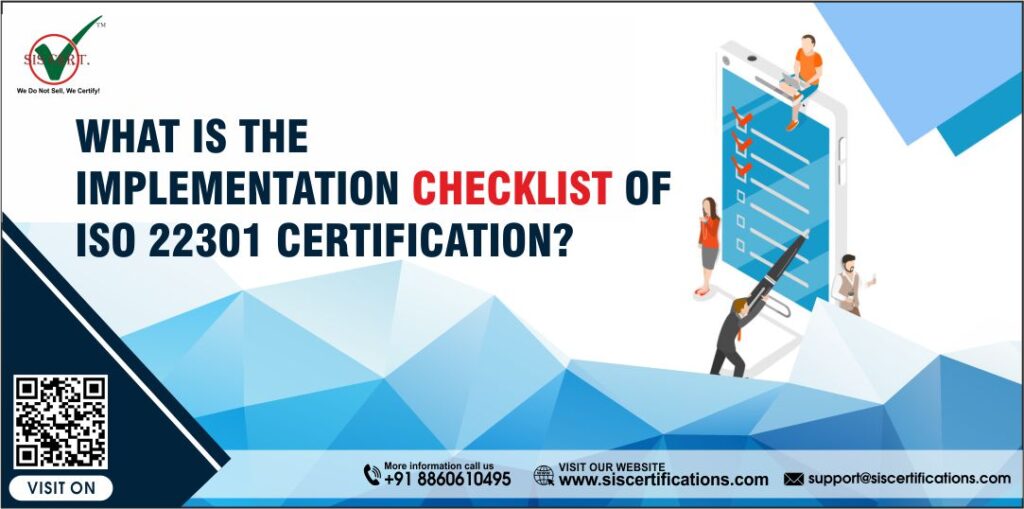
COVID-19 has changed all the dimensions of doing business. It has changed all ways organizations used to follow earlier. It has made us pursue new ideas and ways to conduct day-to-day business operations. Checklist of ISO 22301 Certification a Business Continuity Management System (BCMS) offers a framework for organizations to carry out their business operations and processes without disruption What is ISO 22301 Certification? ISO 22301 Certification is the world’s first standard that provides a framework for Business Continuity Management System (BCMS). It establishes and manages an effective business continuity and aims to provide resilience to organizations to prevent, minimize and recover from disruptive incidents or crisis. The Benefits of ISO 22301 Certification ⮯ The ISO 22301 certification offers the following benefits to an organization: Business protection is significant and safeguards the value of assets and trains an organization to manage its resources. It allows organizations to conduct operations without disruption and execute effective recovery plans when needed. Unifies regional, national, and international regulations in a single framework to establish an effective business Continuity Management System. An organization must comply with all the laws and regulations. Safeguards business investments and income. Checklist of ISO 22301 Certification helps organizations manage their assets. It allows organizations to protect their income during natural calamities and incidents and reduces losses. Increases the reliability and credibility of an organization. It creates a better image among customers and potential business partners and demonstrates its ability and effectiveness in responding to unprepared incidents. Non-conformities are identified and addressed accordingly. An organization must have a contingency plan to manage incidents of disaster or unpredictable occurrences. ISO 22301 standard follows the Plan-Do-Check-Action model to implement effective business management. Ensures continuous business operations and follows a risk-based approach to identify potential risks. It requires formulating strategies to mitigate them and demonstrates the organization’s effectiveness in implementing effective responses and reducing disruptions. Saves the life of employees as it requires conducting fire drills and implementing effective recovery plans. It demonstrates the organization’s concern for the employees’ life and responsibility to provide safe and healthy workplaces. Secures resilience in the supply chain to establish Business Continuity Management. An organization needs a robust and resilient supply chain to provide products and services. A Business Continuity Management System indicates an organization’s commitment and ability to produce opportunities and address risks. ISO 22301 Certification Implementation Checklist⮯ Gaining the support of management – An organization must win the support and confidence of all stakeholders to secure a successful implementation of ISO 22301 Certification. Employees are the human capital of any organization, and their active participation plays a significant role. Determining the requirements – The organization must identify the prerequisites to establish business continuity and communicate them with all stakeholders and interested parties. Defining scope of Business continuity – The management requires defining the policies and responsibilities for business continuity. An organization must determine the scope and objective of business continuity and review the effectiveness and efficiency of the business continuity system. Conducting a risk assessment – An organization requires performing a risk assessment to determine potential risks and opportunities and address them accordingly. Business impact analysis – It defines requirements for an organization to find out two things. That is: Effectiveness of the recovery plan Recovery time objectives are requirements for the successful recovery process. Business continuity plan – There are several kinds of business continuity plans. These are: Incident response plan Recovery plan Training and awareness – A business continuity plan prepares the business for an unexpected incident or crisis. It requires providing necessary training to employees so that they know how to save their lives during an incident. It also instructs the organization to execute mock drills and develop recovery plans. Documentation maintenance – It requires maintaining records and documents of all business operations and helps in assessing their business operations. Performing post-incident reviews – It requires conducting a post-incident review to train employees. A post-incident review allows an organization to evaluate the effectiveness of a recovery plan. Communication – Business continuity depends on the relationship between interested parties, regulatory bodies, authorities, owners, and stakeholders. An organization must establish an effective communication system, internal and external, to keep everyone informed. Performance measurement and evaluation – Performance evaluation enables the organization to understand the effectiveness and efficiency of business operations. It measures the business continuity plans and policies. Performing an internal audit – An organization must conduct an internal audit to identify the weak areas and shortcomings. An internal audit allows organizations to achieve the desired outcomes and eliminate factors that might cause unintended results. Corrective actions – After conducting an internal audit, the organization must implement corrective actions to eliminate shortcomings and mitigate factors that cause undesired outcomes. Conclusion ✅ ISO 22301 is an internationally recognized standard for Business Continuity Management Systems (BCMS). It helps organizations to protect and reduce the occurrence of unprepared events and prepare to respond and recover from incidents disrupting business operations. It seeks to implement, sustain and improve a management system to protect against business-related risks. It follows a risk-based method to identify and address the potential risks and formulates strategies to mitigate them. ISO 22301 certification is a generic standard, and any organization can apply for ISO 22301 certification, regardless of size, nature, and location. Enjoy Reading – What is the importance of ISO 22301 Certification? ISO 22301 & ISO 27001 in an Organization
Know About ISO 37001 Standards
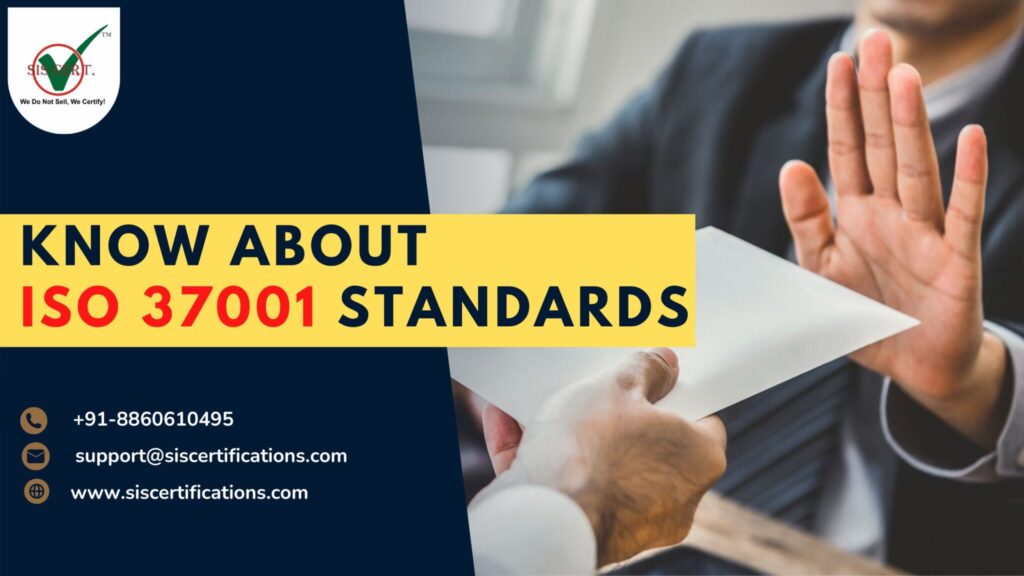
An anti-bribery management system demonstrates an organization’s ability to take proactive measures to prevent bribery. Corruption is a misuse of power and trust, and around 53% of the CEOs or high officials are aware of bribery within their organization; more than $1.5 trillion is the estimated annual cost of bribery, and 75% of the bribery incidents take place through intermediaries. To prevent these corrupt practices and implement ethical business practices, the International Organization for Standardization (ISO) has developed ISO 37001:2016 anti-bribery management system certification. What is ISO 37001? The ISO 37001 Documentation kit for Anti-bribery management system certification provides requirements and guidance for establishing an anti-bribery system. ISO 37001:2016 assures that an organization implements adequate control and addresses risks related to bribery and other forms of corruption. It follows a risk-based approach to identify potential threats and adopts policies and practices to eliminate them. Benefits of ISO 37001 to organizations ⮯ ISO 37001 standards apply to every industry, small and large, regardless of nature and location. An ISO 37001 standard offers the following benefits to an organization: Instils an anti-bribery culture and implements appropriate controls. Requires an organization to adopt ethical business practices and processes. Creates a better reputation of your organization and expands your customer base as well as helps you win new businesses and clients. It lowers the costs and enables an organization to avoid regulatory fines as it requires strict compliance with all the laws, regulations and other standards related to anti-bribery. ISO 37001:2016 Documentation kit for ABMS ⮯ ISO 37001 Manual– It has 10 Chapters and 4 Annexure It contains a sample copy of the system manual and clause-wise details of the implementation of ISO 37001:2016. It consists of the context of organization, objectives, sample policy, scope, organization structure and requirements of ISO 37001:2016 from section 4 to section 10. It has 10 chapters covering the company profile, amendment sheet, index and clause-wise details of ISO 37001:2016 and its implementation process. ISO 37001 Procedure – It consists of 7 procedures It contains a sample copy of mandatory documents of ISO 37001:2016 and covers all the details, such as purpose, scope, responsibility, a list of exhibits, reference documents and formats. in this ISO 37001 Documentation kit the list of sample procedures is as follows: Procedure for document and data control Procedure for corrective action Procedure for internal audit Procedure for management review Procedure for Bribery Risk Management Procedure for training Procedure for investigating and dealing with bribery Process Approach – It contains 10 process templates. It provides guidelines for processes, flow charts and process models for process mapping. It consists of process flow charts and activities of all the processes with an input-output matrix for the organization. It helps organizations in process mapping and preparing process documents. List of Process flow chart: Process Flow Chart of Customer Service Process Flow Chart of Dispatch Process Flow Chart of Engineering Process Flow Chart of Marketing Process Flow Chart of Production Process Flow Chart of Purchase Process Flow Chart of Quality Control Process Flow Chart of System Coordinator Processes Process Flow Chart of Stores Process Flow for Training Activity Policy – It contains only 1 policy It covers all the sample copies of policies related to ISO 37001:2016. Policies are directions provided by the management to achieve the desired outcomes. The list of policies: Anti-bribery and Anti-corruption policy Exhibits – It contains 4 Exhibits It is a helpful tool that focuses on improving and implementing quality requirements and skill requirements. It also includes document identification and codification and the needs and expectations of the stakeholders. The list of exhibits is as follows: Exhibit for Skill requirements Exhibit for Multi skill requirements Exhibit for Document Identification and Codification System Exhibit for Needs and Expectations of stakeholders ISO 37001 Forms and Templates – It contains 34 sample formats. It has a sample copy of blank forms required to maintain records and establish controls. The samples guide the users, and the organization is free to change the same as per its requirements. There are 34 blank formats that can also be used as templates. Filled Formats – It covers 17 sample-filled formats It covers a sample copy of filled forms to maintain records and establish controls. These samples work as a guide for an organization and can be changed based on its requirements. The 17 sample formats can be used as templates. ISO 37001 Audit Checklist – It contains more than 350 questions It contains audit questions based on ISO 37001:2016 requirements for every department. It is an appropriate tool for auditors to prepare audit questionnaires for auditing. It is primarily used for auditing during an internal audit for ISO 37001:2016 Certification. Sample Risk Assessment Sheet – It contains 1 excel sheet template It is a ready-to-use risk template in an editable form used to prepare the risk document for the organization. It is given in excel format. ISO 37001 Compliance Matrix – It contains 1 excel sheet template It is a requirement-wise list of documented information given in the matrix to make it easy for the user to understand how the system works. Conclusion ✅ ISO 37001 certification is an internationally accredited anti-bribery management system standard. It provides tools and techniques for an organization to implement appropriate controls and policies to prevent bribery incidents and makes an organization more reliable and credible. ISO 37001 Documentation kit gives a competitive edge and access to the global market by showing the organization’s compliance with all the national and international laws and regulations. It is a cost-effective standard and increases the revenues of an organization. Tags
Requirements for General Data Protection Regulation
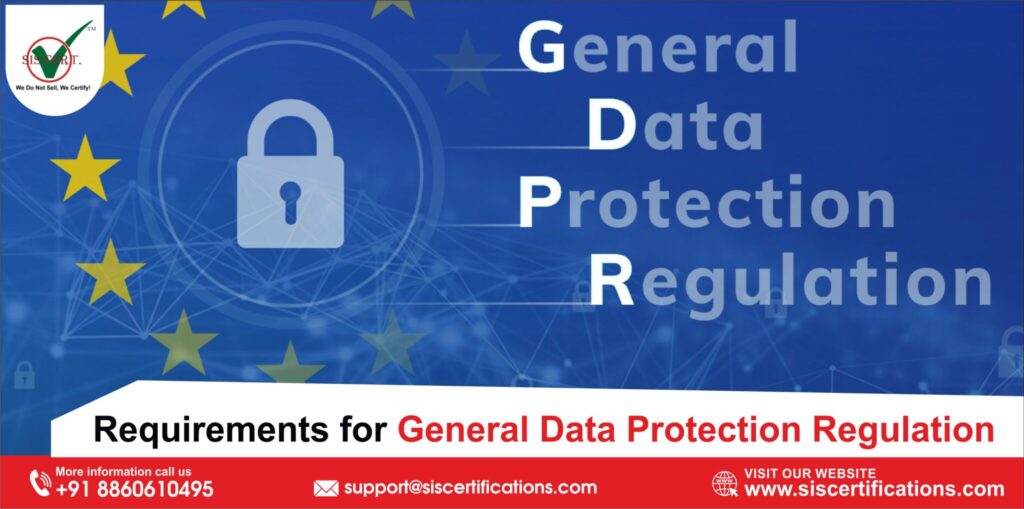
Big companies collect and store consumer data to meet their needs and requirements. With the internet becoming the online business hub, it has given rise to many global problems in which the data is collected, stored and transferred today. Consumers expect more transparency and responsiveness from the organizations and blame the company for their lost data in the event of a data breach, not the hacker. The International Organization for Standardization has developed ISO 27001 certification, ISO 27701 certification, Capability Maturity Model Integration (CMMI) and ISO 27002 certification to ensure information security. The European Union replaced its Data Protection Directive from 1995 and adopted the General Data Protection Regulation (GDPR) to protect the personal data and privacy of European Union citizens. What is General Data Protection Regulation (GDPR)? The European Union adopted the General Data Protection Regulation (GDPR) in April 2016, and it came into effect on May 2018 replacing the outdated data protection directive from 1995. Any organization associated with processing personal data can apply for GDPR linked to European citizens, regardless of its geographical location. The General Data Protection Regulation (GDPR) is the core digital privacy legislation of the European Union. It helps organizations streamline and enhance several core business activities. The GDPR considers information security as an integral part of data protection and occasionally follows a risk-based approach to address risks related to data subjects’ rights and freedom. Data protection is one of the basic requirements of the General Data Protection Regulation to ensure data protection. It does not only apply to digitized data processing but also to the organizations that are into processing and storing personal data on physical supports. The General Data Protection Regulation (GDPR) with ISO 27701 standard focuses on establishing a Privacy Information Management System (PIMS) and safeguards user’s rights and freedom. ISO 27701 Certification is an extension to ISO 27001 certification and ISO 27002 certification. GDPR Requirements Checklist⮯ The GDPR (GDPR) outlines responsibilities for organizations to ensure privacy and information security. It is a set of rules and regulations that guides organizations on how to process the personal data of data subjects. The GDPR not only secures information security but also safeguards the rights and freedom of individuals. The GDPR requirements checklist is as follows: ○ Lawful, fair and transparent processing○ Limitation of purpose, data and storage○ Data subject’s rights○ Consent○ Personal data breaches○ Privacy by design○ Data protection impact assessment○ Data transfers○ Data protection officer○ Awareness and training Step-by-Step Guide for General Data Protection Regulation (GDPR) Requirements ⮯ Lawful, fair and transparent processing – To ensure GDPR compliance an organization must follow six lawful reasons for the processing of data. These are: Consent Contract Legal Obligation Vital Interest Public Task Legitimate Interests It requires an organization to process data in a lawful, fair and transparent manner. A GDPR sets out rules and regulations for organizations and provides a GDPR requirements checklist to identify the legal basis for processing personal data. Limitation of purpose, data and storage – Companies must collect the required data and should not keep data once the processing purpose is completed. Data collection should be done only for specific, explicit and legitimate purposes. It provides transparency and protects the personal information of users. An organization must follow these GDPR requirements: Personal data should not be processed for any purpose other than legitimate purposes. The organization must collect only the necessary data. Deleting the data collected once the legitimate purpose was fulfilled. Data subjects rights – The General Data Protection Regulation (GDPR) enshrined eight data subject rights. These are: Right to be informed Right of access Right to rectification Right to erasure Right to restrict processing Right to data portability Right to object Rights related to automated decision making including profiling Consent – An organization must provide consent information in explicit, clear and plain language. Organizations require the consent of parents/guardians if the child’s age is under 16. The consent must be collected and documented, and a data subject is allowed to withdraw consent at any moment. Personal data breaches – Article 4 of the GDPR defines personal data breaches as an incident leading to accidental or lawful destruction, loss, or access to personal data. The GDPR compliance mandates an organization to maintain a personal data breach register and inform the regulator or data subject within 72 hours of identifying the breach. Privacy by design – It requires an organization to implement the best practices to ensure information security and privacy. It incorporates organizational and technical mechanisms to protect personal data by designing new processes and systems. Data Protection Impact Assessment (DPIA) – A Data Protection Impact Assessment (DPIA) identifies and minimizes privacy risks. An organization must conduct a DPIA when a significant change is introduced in the processing of personal data, including new processes, change to an existing process, or new project. Data transfers – The personal data controller is responsible for ensuring that the personal data of the users is protected and that GDPR requirements are fulfilled. The controllers must ensure data protection and privacy even if the data processing is done by a third party. Data protection officer – A Data Protection officer (DPO) is an independent body that advises and monitors an organization on how to comply with GDPR regulatory requirements. Awareness and training – Organizations must provide training to employees related to EU GDPR requirements. A staff awareness training program is mandatory as it enables organizations to adopt responsible data protection practices. Conclusion ✅ The General Data Protection Regulation (GDPR) outlines the requirements for an organization to ensure information security. It provides a set of rules and regulations for organizations that are related to data collecting and processing. It requires an organization to conduct an incident management plan and identify risks related to data processing. The gdpr certification cost varies from organization to organization depending on its size, number of employees, number of branches and the certification body selected by the organization. Enjoy Reading – ISO 45001 Certification Process in Singapore CMMI Certification ISO Certification in Cochin Tags
What are the six elements of ISO 14001?
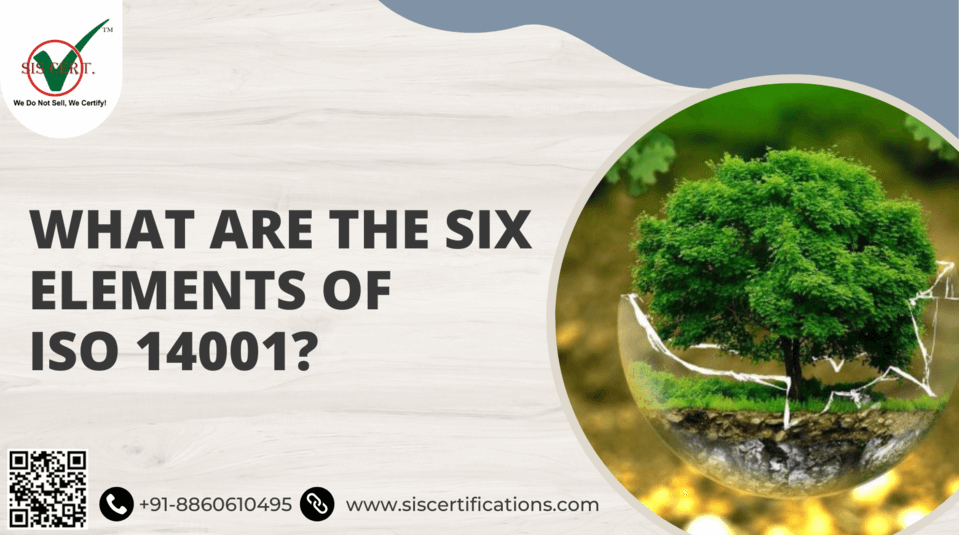
The environment provides us with the basic life support system, including air, water, food and land. The atmosphere and its ecological health is being negatively impacted due to the unwarranted disposal of waste into the earth’s natural resource pool. Studies show that over 70% of total office waste is recyclable; however, only 7.5% gets recycled. The International Organization for Standardization (ISO) has developed ISO 14001 Certification to improve the environmental performance of organizations. What is ISO 14001 Certification – Environment Management System? ISO 14001 certification is an Environment Management System (EMS) standard that provides a framework for providing the environment and reducing waste management costs. ISO 14001 standard compliance demonstrates an organization’s commitment to helping businesses and other industries to reduce their environmental impacts. ISO 14001 standard focuses on enhancing an organization’s environmental performance and helps organizations systematically manage their environmental responsibilities to contribute to the environmental pillar of sustainability. What are the ISO 14001 Certification Checklist?⮯ ISO 14001 certification aims to enhance an organization’s environmental performance and eliminate all those processes and procedures that can cause negative environmental impacts. The legal requirement of ISO 14001 certification checklist is as follows: Evaluating the organization and building a team Demonstrating leadership Establishing an effective communication system Encouraging employees to participate actively Determining the action plan and scope of the Environment Management System Creating an ISO 14001 Certification Project Plan Provides Management Tools Reviewing and Monitoring the Performance of ISO 14001 Certification Conducting ISO 14001 Mandatory Internal Audit Acquiring an ISO 14001 Certification that Promotes Certification and Sustainability Measuring the Results Continuous Improvement Six Key Elements of ISO 14001 Certification ⮯ Environment Policy – It requires an organization to outline its environmental policy. An organization must determine business objectives and targets based on its Environment policy. ISO 14001:2015 standard incorporates the principle of sustainable development and performance indicators associated with EMS. The organization needs to establish effective communication, internal and external, to ensure ISO 14001 certification compliance. Planning – Designing plans and strategies for implementing the Environment Management System (EMS). Effective planning and implementation help an organization assess the environmental impacts of business operations. Planning helps organizations identify compliance requirements and document targets and objectives. Implementation – Executing a plan efficiently and effectively is much more valuable than formulating it. It incorporates adjustments and builds new processes and procedures to adapt to changing requirements. An organization requires defining, documenting and communicating the implementation process to give necessary training to employees. It also includes emergency response planning and preparedness. Study and Correction – After implementing the EMS, the organization measures its performance and focuses on optimizing it. It involves reviewing and evaluating existing and new procedures to ensure KPIs are achieved and the effectiveness of EMS. Management Review – A management review is a formal evaluation of the effectiveness of the organization’s Environment Management System. It is one of the most significant elements, as it ensures that everything is functioning within the determined scope. It takes into account any new environmental issue, legislation and changing circumstances. Continuous Improvement – It enables an organization to optimize all aspects of the system and ensures the Environment Management System (EMS) utilizes principles of continuous improvement. The principle of continuous improvement follows the Plan-Do-Check-Act cycle to improve business processes and procedures. Conclusion ✅ ISO 14001 certification is an internationally recognized standard developed by the International Organization for Standardization (ISO) that provides a framework for enhancing an organization’s environmental performance. It is a generic standard, and any organization can apply for ISO 14001 standard regardless of size, nature and location. The cost of ISO 14001 Certification varies from organization to organization depending on its size, number of employees, number of branches and the certification body selected by the organization. Enjoy Reading – ISO 9001 Certification in Kuwait ISO 9001 Certification in Bangalore ISO 9001 Certification in Uzbekistan Tags
GDPR Certification Complete Guide
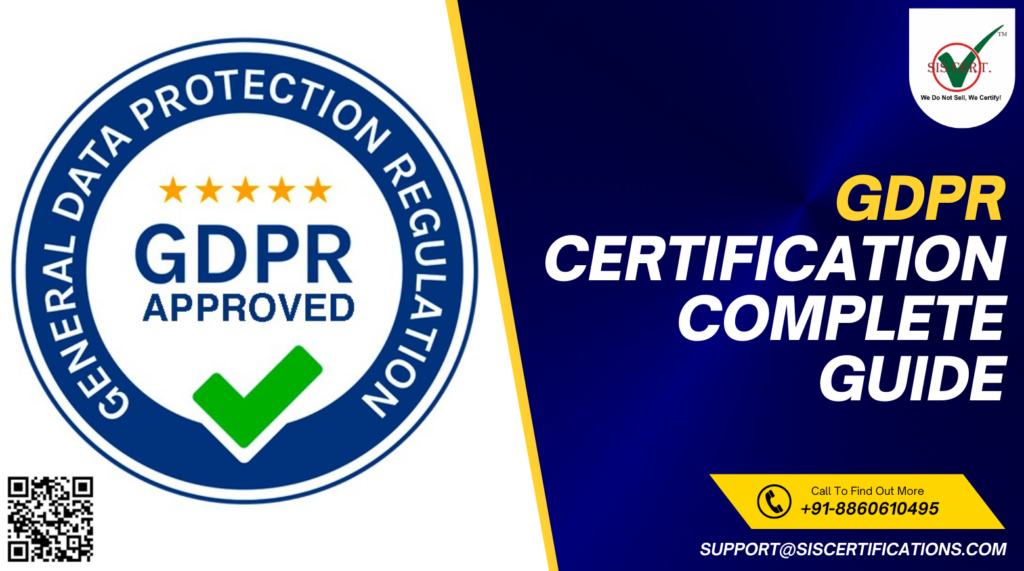
While browsing the website, we have a tendency to accept cookies. Have you ever thought, what are these cookies? Cookies are small pieces of text files that a website sends to your browser on your device. These are processed and stored by the website you visit. Cookies are harmless and can be easily viewed and deleted. Websites focus more on asking a user to accept cookies because of a data privacy protection law that governs online data tracking and transparency. This data privacy protection law was enacted by the European Union, known as General Data Protection Regulation (GDPR). What is General Data Protection Regulation (GDPR)? The General Data Protection Regulation (GDPR) is the European Union law that entered into effect on May 25, 2018. It is one of the most rigorous privacy and security law in the World and imposes obligations on every organization related to data collecting of the European Union (EU) people. GDPR compliance demonstrates an organization’s commitment to privacy and data security. It incorporated the new data protection act and established European Data Protection Board (EDPB) which represents all the EU member states, and ICO is the United Kingdom’s representative body. The General Data Protection Regulation (GDPR) not only focuses on information security but aims to protect user’s privacy and individual rights. It establishes rules for data collecting and processing organization and encourages free movement of data within the European Union. The General Data Protection Regulation (GDPR) Requirements⮯ The GDPR compliance improves an organization’s data protection mechanisms and offers better privacy and information security for employees, interested parties and customers in the EU. The GDPR requirements are as follows: Legal bases for data processing – Article 6 of the GDPR sets out the requirements for processing data lawfully and defines six legal bases, at least one of them must be followed. These six legal bases are: Consent was taken from the data subject for the data processing. Data processing is essential for the performance of a contract. Data processing is necessary for compliance with legal obligations. It is necessary to safeguard the interest of the data subject. Performing particular tasks in the public interest. Data processing is necessary for legitimate interests. Consent – Consent is one of the most significant parts of GDPR compliance and aims to protect privacy and individual right. The GDPR outlines that the data subject must give consent freely for processing the data. It requires an organization to present the consent information in easily accessible, clear and plain language. Consent for children must be verifiable consent from their parent/guardian and mandates an organization to ensure the person giving authority holds the parental responsibility for the child. It also simplifies the mechanism for a data subject to withdraw consent. Data subject rights – The GDPR aims to protect data subject’s rights and freedom. It outlines the obligation for data controllers to respond to the data subject’s rights request within one month. The checklist of data subject rights offered by GDPR is: Right to be Informed Right to Access Right to Rectification Right to be Forgotten Right to Restrictions of Processing Right to Data portability Right to Object Right to not be Subject to a Decision Based Solely on Automated Processing International data transfer – Article 44 sets out the conditions for transferring personal data outside the European Union. The GDPR outlines the conditions for data processors and data controllers to transfer data outside the EU if: The transfer is done as per the European Commission adequacy decision. Article 44 states that the transfer is subject to appropriate safeguards, such as: Standard contractual clauses Codes of conduct Approved certification mechanisms The transfer is subject to Binding Corporate Rules (BCRs) It relies on derogation. Supervisory authority – Article 57 outlines the responsibilities of the supervisory authority. A supervisory authority monitors and implements the application of the General Data Protection Regulation (GDPR). It requires an organization to establish an independent and competent supervisory authority body to check GDPR compliance. General Data Protection Regulation (GDPR) Compliance Checklist ⮯ Organizations associated with data collecting and processing can apply for General Data Protection Regulation (GDPR). The GDPR compliance checklist is as follows: Determining an action plan using the seven principles of the General Data Protection Regulation. Article 30 mandates organizations to create a record of processing activities. Implementing privacy by design and processes for performing Data Protection Impact Assessments. Developing a framework for consent management. Understanding the requirements for cookie consent based on the countries where it operates. Creating a request portal for data subjects to ensure data subject’s rights. Review risks from data processors. Conducting an incident management plan. Mechanisms to review internal data transfers. Rolling out GDPR training programs. Appointment of a Data Protection Officer (DPO) (Where needed). Conclusion ✅ The General Data Protection Regulation (GDPR) specifies the requirements for an organization to ensure information security. There are other ISO standards that aim to secure information, including ISO 27001 Certification, ISO 27701 Certification and ISO 27002 Certification. The ISO/IEC 27001 and ISO/IEC 27701 focus on datasets structured in Information Technology assets, while the GDPR also includes unstructured datasets stored in file cabinets. The cost of acquiring the GDPR Certification bodies differs from organization to organization depending on its size, number of branches, number of employees and the certification body selected by the organization. Tags
Checklist for Safety Audit Do’s and Don’ts
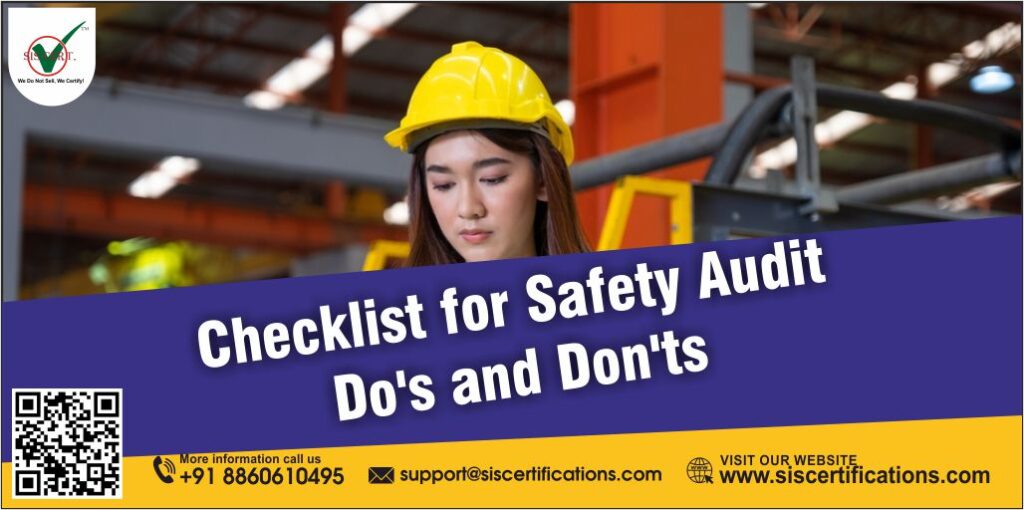
A safety audit is a valuable tool used by all organizations regardless of size, nature and location. A safety audit is significant for organizations and employees and is conducted by a third party to measure the organization’s ISO 45001 Certification compliance. What is a Safety Audit? A safety audit provides a systematic process for an organization to gather information related to the organization’s effectiveness, efficiency, safety and reliability. It focuses on identifying the health and safety hazards and measures the effectiveness of control implemented by the organization. It evaluates and oversees compliance with Occupational Health and Safety Management System. Safety audits are complex and review documents, processes and safety management systems to measure compliance with ISO 45001. An auditor oversees the process, work environment, equipment and other related factors of the health and safety system. Objectives of safety audit – The four main objectives of a safety audit are: Focuses on identifying work-related hazards and implementing appropriate controls to eliminate them to make workplaces safe and healthy. Oversees the effectiveness and compliance with safety programs implemented by the organization. Ensures that an organization adopts the best business practices and processes and that the facility, equipment and operations meet safety requirements. Measures and mandates organizations to adopt adequate record-keeping practices. Phases of Safety Audits⮯ The Safety Audit consists of six phases. These are: Safety Audit Preparation Facts Finding Reviewing the Findings of the Safety Audit Recommendations from the Safety Audit Undertaking Corrective Actions Publishing the Results of the Safety Audit Purpose of a Safety Audit ⮯ Around 1.7 million workers suffer from work-related ill health and accidents. ISO 45001 standard aims to provide a safe and healthy workplace to workers and ensure their mental and physical well-being. The purpose of safety audits is as follows: Preventing work-related incidents and accidents – ISO 45001 certification mandates an organization to conduct periodic health and safety audits to measure the effectiveness and efficiency of processes and reduce work-related accidents and diseases. A safety audit inspects the condition of the workplace to reduce the incidents of slips, trips and falls, manhandling and other issues related to safety. Measures Compliance – It measures the organization’s compliance with ISO 45001 standards and requirements. A safety audit ensures that an organization complies with all the requirements listed in clauses 4-10 and provides necessary training and tools to employees to attain occupational health and safety. Protects organization’s reputation and brand name – Non-conformities with health and safety laws and regulations can result in heavy fines/penalties and imprisonment. A safety audit oversees the organization’s compliance with all the health and safety laws and standards. It allows an organization to avoid regulations, protects its brand name and creates a better reputation of the organization. Enhance the productivity of employees – It creates a positive safety culture within the organization and demonstrates its commitment to secure employee’s safety and well-being. It boosts employee’s confidence and trust as it reduces work-related injuries, accidents and diseases and enhances productivity. Do’s of a Safety Audit⮯ An organization requires ensuring the following things during a safety audit: An organization should ensure a positive work environment to boost employee morale and productivity. Collaborating with a competent health and safety auditing company having credentials and experience. Conducting audits can be time-consuming and require adequate training. It is necessary for an organization to build and customize an accurate Safety Audits CheckList based on the organization’s needs and requirements. Formulating appropriate and clear corrective action plans and documenting them. ISO 45001 Certification follows a risk-based approach to identify health and safety risks and requires developing policies and plans to eliminate them. The organization must train and empower its employees so that they would be able to perform the particular job efficiently and reduce the chances of work-related injuries and diseases. An organization must conduct periodic internal audits to check ISO 45001 Certification compliance and meet the requirements of OH&SMS. Don’ts of a Safety Audit⮯ An organization should not promote the following things during a safety audit: Restricting site inspections to only some parts of the workplaces. Limiting the organization’s discussions to only some members of the workforce. Not allowing permission to interview employees in private. Manipulating the auditor to review and evaluate only those records and documents that would appear to have already been vetted. Discouraging the auditor from evaluating records and documents randomly from electronic or hardcopy files and presenting folders of prepared evidence only. Trying to hide electronic folders or files from the auditor. Type of Safety Audits⮯ Fire Safety Audits Electrical Safety Audits Health And Safety Audits Road Safety Audits Conclusion ✅ ISO 45001 Certification specifies the requirements for Occupational Health and Safety Management System OHSMS standard. It also mandates an organization to conduct periodic safety audits to ensure compliance with OHSMS. A safety audit reviews and evaluates an organization’s health and safety system to identify safety hazards and work-related risks. It aims to create a safe and healthy workplace for employees and reduces work-related injuries, incidents and diseases. Tags
Certified Data Protection Officer
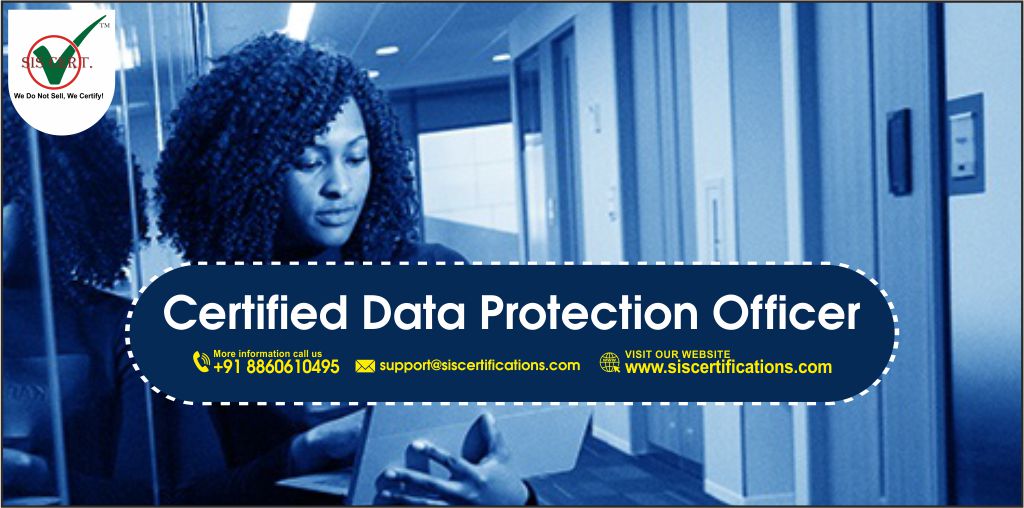
A Data Protection Officer is a security leadership role in an enterprise mandated by General Data Protection Regulation. The Data Protection Officer is responsible for reviewing the organization’s compliance with the General Data Protection Regulation (GDPR) as well as the organization’s data protection strategy. Companies processing a large amount of data that fall in the domain of special categories of personal data and public authorities must appoint a data protection officer to oversee the organization’s data protection strategy. Who is a Data Protection Officer (DPO)? The data protection officer supervises the implementation of data protection regulation and data privacy strategy in an organization. The Data Protection Officer fosters the culture of data protection within the company and ensures compliance with General Data Protection Regulation (GDPR). The appointment of a Data Protection Officer (DPO) does not depend on the size of an organization but depends on the size and scope of the data handling. A DPO directly reports to the highest management level, and General Data Protection Regulation (GDPR) offers Data Protection Officers security from being laid off for doing their job. Which organizations need a Data Protection Officer?⮯ The European Union mandates the appointment of a Data Protection Officer in the organizations that process and store personal data. However, there are four factors that help organizations determine the need for a Data Protection Officer. These are: Data Subjects Data Items Length of Data Retention Geographic Range of Processing Generally, small-scale businesses do not require Data Protection Officers unless their primary focus is Data collection and storage. Role and Responsibilities of DPO in Data Compliance ⮯ The Data Protection Officer is not accountable and responsible for any non-compliance with General Data Protection Regulation. Reviewing and monitoring compliance with GDPR is the responsibility of the controller or processor. The General Data Protection Regulation article 37 mandates the requirement for a DPO for organizations that are associated with collecting and processing EU citizens’ personal data. The Data Protection Officer is appointed to do the following tasks: Monitoring compliance with the General Data Protection Regulation (GDPR) – It includes: Collecting information to identify processing activities. Analysing and evaluating the compliance of processing activities. Brief, suggest and publish recommendations. Data Protection Impact Assessment (DPIA) – It consists of the following: A DPO determines whether or not to conduct a DPIA. Selection of methodology to be followed to carry out DPIA. Determining whether to conduct in-house DPIA or outsource it. Determining controls, including technical and organizational, to protect information and eliminate risks related to the rights and interests of data subjects. Prepares the final reports on whether the assessment is correct or not and the organization’s compliance with the GDPR. Working in cooperation with the supervisory authority. Follows a risk-based approach. Record keeping. Article 39 outlines the following responsibilities for a Data Protection Officer: A DPO educates the organization and its employees regarding the significance of compliance requirements. Trains the staff involved in data processing. To ensure compliance s/he conducts audits frequently and proactively address potential issues. S/He serves as the facilitator between the organization and GDPR supervisory authorities. A Data Protection Officer evaluates the performance and provides suggestions on the impacts of the data protection strategy. Focuses on maintaining all the records of the activities associated with data processing, including the purpose of the data processing activities (must be made public on request). Communicates and informs data subjects on how their data is being used by the organization, aware of their right to have their personal data erased and reviews the measures and controls implemented by the organization to protect the personal information of data subjects. Qualification Requirements ⮯ There are no specific qualification requirements for Data Protection Officer, but article 37 of General Data Protection Regulation requires a DPO to have expert knowledge of data protection laws and practices. It also requires a DPO to align its activities with the organization’s operations associated with data processing. The following are the pre-requisites to become a Data protection Officer: Minimum GCE “O” level or above Should have completed the Singapore WSQ “Fundamentals of the Personal Data Protection Act” training by an accredited with a certificate, or equivalent Minimum 2 years of work experience with at least 6 months as a Data protection officer Submission of at least one write-up on data protection project implementation. Certification Process ⮯ A Data Protection Officer oversees the organization’s compliance with the General Data Protection Regulation and its data security policy. To become a Certified Data Protection Officer, one has to follow the following procedure: Register yourself online Submitting your documents and payments Preliminary check by the Certification body Examination Conduction of the interview Final review Achievement of Certified Data Protection Officer (CDPO) certificate Re-certification Data protection Officers – Checklist ⮯ The checklist for a Data Protection officer is as follows: Appointment of a Data Protection Officer Position of a Data Protection officer Tasks of a Data Protection Officer Accessibility of the Data Protection Officer Why should one go for DPO Training? ⮯ The General Data Protection Regulation (GDPR) mandates an organization to appoint a Data Protection Officer, if it: Is a public authority. Monitors data subjects regularly and systematically. Process special category of data subjects on a large scale. The DPO (DPO) training helps to turn an individual into a promising asset for an organization. It helps an individual in the following ways: Provides expertise and ahow better understanding of data protection laws and enhances the GDPR knowledge of the individual. Makes an individual an independent advisor, who plays a significant role in monitoring and directing the organization to successfully implement data protection practices. Prepares the organization for disasters and unprecedented events such as data theft and data breaches. Tags
Fighting corruption with ISO 37001 Certification in India
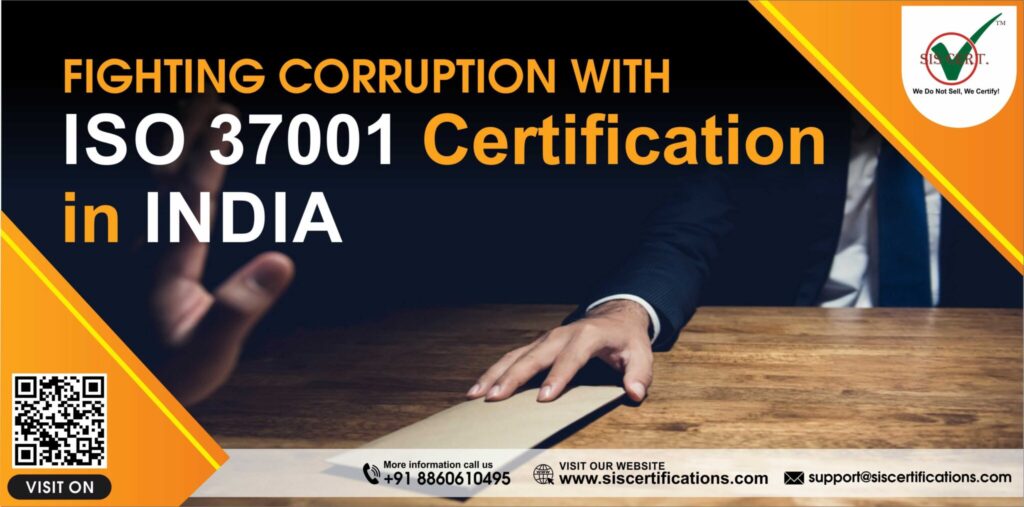
Transparency International defines Corruption as the abuse of entrusted power for private gain. Corruption destroys trust, weakens democracy and hampers economic development. It heightens inequalities, poverty, social division and environmental issues. There can be petty corruption which affects the fundamental rights and services of the public and grand corruption scandals. India is the 6th largest economy and is at 85th position in terms of corruption, which means half of the countries are less corrupt than India. Corruption in India Transparency international is a German-based non-government organization that publishes an annual corruption perceptions index. India ranks 85th among 180 countries in transparency international’s corruption perception index. As per the reports published by Trace International on nine states of India states that: Government officers demand 91% of the bribes. 77% of the bribes were demanded to avoid harm. 51% for timely delivery of services.. Corruption is a grave economic issue and affects a country’s achievement and development goals. It promotes inefficiencies and inadequate use of resources and is a threat to national security. According to corruption economist Mauro- If corruption in India reduces to the level of Scandinavian countries, then investment in India would rise by 12% annually and additional GDP growth by 1.5%. The Indian Government loses around 2 lakh crores annually due to tax evasion. India strives to become a 5 trillion dollar economy. To achieve this feat, it needs to eliminate the evil of bribery from society. The International Organization for Standardization has developed ISO 37001 Certification Anti Bribery Management Certification to fight with the evils of corruption and promote just and fair business practices. What is ISO 37001 Certification Anti Bribery Management Certification? ⮯ An ISO 37001 Certification provides a framework for an Anti-Bribery Management System (ABMS). It helps organizations to implement an anti-bribery management system and specifies a series of measures that an organization can implement to help, prevent, detect and address incidents of bribery. It aims to instill an anti-bribery culture and offers appropriate tools to detect bribery to implement effective controls. ISO 37001 standards apply to any organization, public, private and not-for-profit organizations regardless of their size, nature and geographical location. It requires the appointment of an officer to oversee the compliance with bribery law, regulations and international standards and provides guidance and training to the employees to adopt anti-bribery practices. Benefits of ISO 37001 Certification ISO 37001 standards offer the following benefits to organizations: Advocates ethical business practices and establishes an anti-bribery management system. Non-compliance with laws and regulations can lead to penalties and fines. The ISO 37001 standard creates a better image of an organization and provides a competitive edge. Implementation of suitable anti-bribery procedures. Better protection of the organization’s assets and resources and increases revenue by adopting fair and just business processes. Reduces the malpractice and incidents of bribery and related hazards. It promotes transparency and accountability, which makes your brand reliable and credible and helps you win new businesses. Boosts morale of the employees increases productivity and lowers structural and miscellaneous costs. Embeds existing laws and regulations related to anti-bribery management in a single framework and provides a holistic approach. Reduces risk by following a risk-based approach. It focuses on identifying the potential threats to anti-bribery management and implements adequate controls to eliminate the risk of bribery. Your organization demonstrates the ability to meet customer’s needs and requirements and promotes equitable access to products. Conclusion ✅ ISO 37001 Certification is an internationally accredited standard developed by International Organization for standardization. ISO 37001 standards are generic and apply to all organizations, public, private or not-for-profit organizations, regardless of size, nature and location. It aligns with the organization’s objectives and integrates other laws, regulations, and standards into a single framework to establish an anti-bribery management system. ISO 37001 cannot guarantee that there will be zero corruption but aims to provide robust and appropriate measures that help in reducing the risk of bribery and address bribery incidents. TAGS: abms, anti bribery, Apply ISO 37001 ABMS Standard, bribery risk, bribery sector, business transparency, corruption in india, fight with corruption, india gdp, ISO 37001 Anti Bribery Management Standard, ISO 37001 Anti Bribery Management System Certifications, ISO 37001 Certification provider, ISO 37001:2016 Anti Bribery Management System Certifications, ISO 37001:2016 Standard
ISO 26000 Guidelines for Social Responsibility
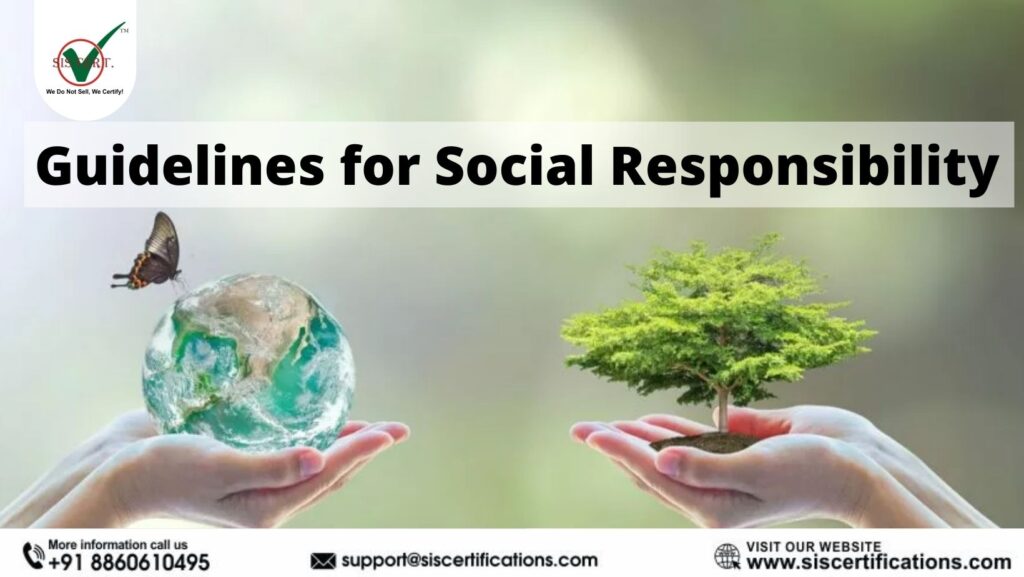
Social responsibility is an ethical theory that motivates organizations to work in a balanced way. It suggests that an organization should focus on development, but at the same time, it should act responsibly for society. Profit generation is significant for an organization, but its actions should positively affect society and the world. What is ISO 26000 Certification? ISO 26000 is an internationally accredited standard for Social Responsibility. It is not a management standard but guides the organization on social responsibility. The ISO 26000 standard supports and promotes Sustainable development, as it motivates the organizations to consider the impacts of their operations on the wider social issues and environment. ISO 26000 is an international standard to help organizations effectively assess and address social responsibilities that are relevant and significant to their mission and vision, operations and processes, customers, employees, communities and other stakeholders and environmental impact. It also includes very small organizations, also known as Micro organizations. ISO 26000 standards work on seven principles. These are:⮯ Principle 1: Accountability Principle 2: Transparency Principle 3: Ethical behaviour Principle 4: Respect for stakeholder interests Principle 5: Respect for the rule of law Principle 6: Respect for international norms of behaviour Principle 7: Respect for human rights Benefits of the ISO 26000 Certification ⮯ It demonstrates that your organization is concerned about social issues and the environment and builds customer’s trust and confidence in your goods and services. ISO 26000 standards can benefit an organization in the following ways: Secures a good impression and a better reputation in the market. Offers a competitive edge and access to the global market Complies with all the local, national and international laws and regulations and existing ISO standards that promote responsible business operations. ISO 26000 standards help organizations to implement effective tools to address social responsibility. An ISO 26000 standard demonstrates your organization’s commitment to the environment and society. It considers environmental, legal, political and organizational diversity. Leverages your organization and improves the relationship with organizations, governments and communities where it operates. Guidelines for Social Responsibility ⮯ Guidance on social responsibility is an international guideline on social responsibility. These guidelines were developed by International Organization for Standardization. The guidance for Social Responsibility contains seven core subjects. These are: 1. Organizational GovernanceThe first step in any organization is to define its scope and objectives. An organization also determines the impact of its actions on society and the environment. Organizational Governance includes all the formal and informal mechanisms and structures and integrates seven principles of Social Responsibility into decision-making. 2. Human RightsUnited Nations states- “Human Rights are rights inherent to all human beings, regardless of race, sex, nationality, ethnicity, language, religion or any other status.” Human Rights are classified into two broad categories civil and political rights. ISO 26000 standards do not support any practice and activity that risk human rights. 3. Labour PracticesOrganizations are the major source of jobs in society, and an ISO 26000 standard encompasses all the policies and practices, including recruitment, promotion, transfer and termination. ISO 26000 standards provide training to develop required skills and adopt worker-friendly procedures and practices. 4. Environmental ResponsibilityThe environment provides us with resources and makes our life better. Environment protection is at the core of the ISO 26000 standard. The global population and consumption are increasing, causing serious social and environmental threats. ISO 26000 standards align with the Sustainable Development Goals and create a balance between development and the environment. 5. Fair Operating PracticesIt examines an organization’s relationship with other organizations, including relationships with government agencies, as well as relationships with their partners, contractors, suppliers and others to promote positive impacts. It requires an organization to follow fair and just practices and procedures and encourages social responsibility in the value chain. 6. Consumer IssuesThe consumer is the god as all the activities in the organizations are consumer-oriented and meet customer’s needs and requirements. Apart from other responsibilities, it is equally important to communicate the right information and fair marketing practices. An organization should provide excellent consumer support, service, and grievance redressal forums and promote sustainable development. 7. Community Involvement and DevelopmentCommunity Involvement and Development Community involvement and community development are the two most important initiatives taken by any private and public organization. Organizations are also a citizens of their community, and an organization must be a good citizen. Cost of ISO 26000 certification ⮯ The cost of ISO 26000 Certification varies from organization to organization. ISO 26000 standards apply to any organization, large and small, irrespective of the size, nature and location. The cost of an ISO 26000 Certification depends on many factors, such as: a. Size of your organization, b. The number of employees in your organization, c. Location of your organization, d. The number of branches your organization has and many others. The cost of ISO 26000 certifications also depends on the Certification body you choose. ISO 26000 certification in India ⮯ SIS Certifications is the leading ISO Certification body in India. SIS Certifications have trusted clients in over 30 countries and operational offices in over 10 countries. It is a trusted certification body accredited by IAS, IAF and IAOS. SIS Certifications is a dedicated team of auditors and technical experts committed to helping you manage risks and access the global market. Conclusion ✅ The ISO 26000 certification is an internationally accredited standard for Social responsibility. It provides a framework for developing tools and practices to address and assess social responsibilities. It is a holistic standard which guides organizations to consider their social and environmental impacts. It promotes the use of fair and just practices and aligns organizational objectives with ISO 26000 standards. It works on seven principles and promotes equitable growth. Tags
Steps for becoming ISO Certified in India
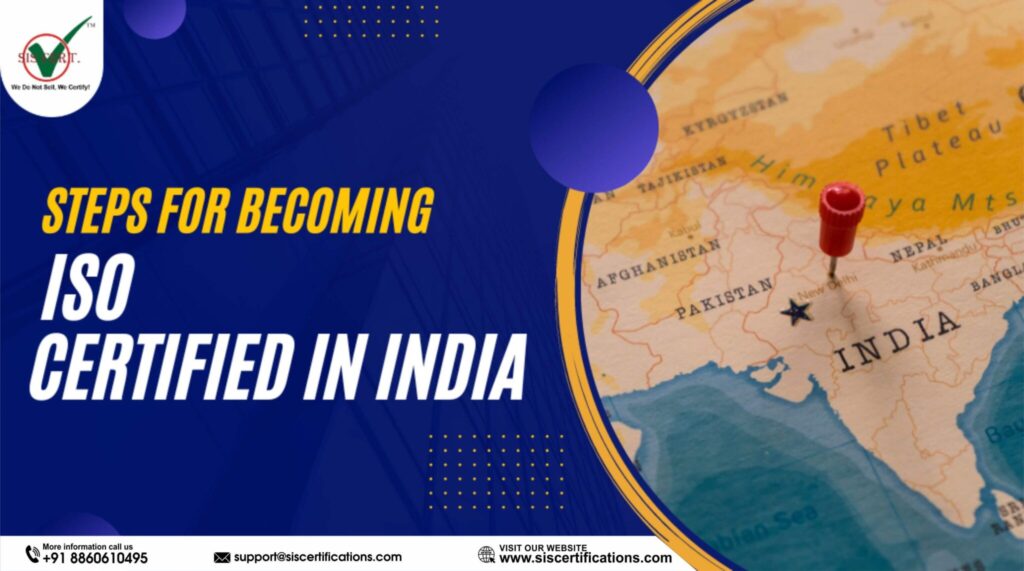
becoming ISO certified in India is a rewarding achievement for any organization. The process of acquiring one is complex, but there are several steps you can take to ensure that your business meets the specific requirements for an ISO certification. Reaching this level of quality will benefit the business and customers and make it easier for more people to trust their products or services. The International Organisation for Standardisation (ISO) is an independent, non-governmental international organisation. It is an organisation with a membership of 167 national standards bodies. What is ISO Certification? An ISO Certification is documentation that the industry operates on the international standards defined by ISO (International organisation for standardisation). There are more than 22000 types of ISO Certifications covering almost every industry. However, some apply to most trades, such as ISO 9001. Benefits of Applying ISO Certification in India⮯ The ISO Certification offers the following benefits, it includes: A certificate assures that you have met requirements applicable to the organization and its products, services, and processes. It is internationally recognized and demonstrates your industry’s commitment to high quality. It enhances the international reputation as the gold standard of excellence in quality management. The ISO certification is the standard for quality management system and ensures that a company meets high-quality standards and contributes to a prosperous business around the globe. An ISO Certification indicates that the organization, its employees, and its systems have achieved specific training requirements. getting ISO Certified in india shows the reputation and credibility of a company. It also helps to establish consistent, reliable performance standards within your organization. ISO certificates are a non-negotiable requirement for all certifications. Before you can get iso certified, you must first get approved by the higher-level bodies and prove your knowledge of all ISO documentation. How to get an ISO Certification in India ⮯ Issuing ISO certificates is an essential part of quality control in Indian industries. Worldwide certification bodies such as International Organization for Standardization (ISO), the American Society for Quality (ASQ), and American National Standards Institute (ANSI) are providing standards to businesses globally. ISO certification is a class of quality certification standards that assures that a product or service (or a combination of products and services) meets specific requirements. An ISO certification body, such as an accreditation body or survey team, employs designations and other means to demonstrate that the manufacturer complies with relevant standards and guidelines. Determine the type of ISO Certification – You have to determine the ISO requirements in india for your organisation and select the type of Certification. Select an ISO Certification bodies – Choose a recognised and ISO Certification body to get iso certified in india. An external body offers certification to the organisations, as ISO does not provide certification directly. Creation of an application form Reviewing documents Making an action plan Conduction of initial certification audit Issuing certification Conduction of internal audits Types of ISO Certification in India ⮯ ISO 9001- Quality Management System ⮯ ISO 9001 QMS is one of the most generic ISO standards. It defines the requirement for a quality management system. It promotes the manufacturing of good quality products and services, as it strives to deliver the same to its customers. It concentrates on creating the same quality products to meet customer and legal requirements ISO 14001- Environment Management System ⮯ ISO 14001 Environmental Management System promotes an effective environmental management system. It integrates environment management practices with ISO 14001 standards and encourages efficient use of resources. ISO 45001- Occupational Health and Safety Management System ⮯ ISO 45001 Occupational Health and Safety Management System enables the industry to provide safe and healthy workplaces and controls work-related injury and ill health. ISO 22000 – Food Safety Management System ⮯ ISO 22000 Food Safety Management System promotes the implementation of an effective food safety management system. It aims to deliver safe and healthy food products to meet customer requirements. ISO 37001 – Anti Bribery Management System ⮯ ISO 37001 Anti-bribery Management System allows businesses to detect, control and manage bribery. It is a hallmark of trust and shows the industry’s adherence to complying with anti-bribery laws and regulations. It provides a framework to address the risks associated with bribery and corruption and makes the business credible.. ISO 13485 – Quality Management System for Medical Devices ⮯ ISO 13485 Certification also known as Quality Management System for Medical Devices, is a standard derived from ISO 9001. It demonstrates an organization’s capacity to supply quality medical products and ensures the quality of products and services related to medical devices. ISO 41001 – Facility Management System ⮯ ISO 41001 Facility Management System provides a framework for effectively executing a facility management system in an organization. It incorporates distinct entities within the business to make the management system easier. SOC1 – Service Organisation Control 1 ⮯ SOC 1 Certification assures the conduction of SOC1 audit on the organization’s services concerning clients’ financial reports and information. It certifies that the company follows best practices to safeguard customers’ data concerning finance, security, privacy, and processing integrity. GDPR certification ⮯ General Data Protection Regulation which is the heart of European legislation on digital confidentiality. It requires companies to safeguard the personal information and privacy of EU citizens for transactions carried out within the EU Member States. And non-compliance could end up costing businesses. ISO 27701 – Privacy Information Management System (PIMS) ⮯ ISO 27701 certification ISO 27701 Certification is a global standard that provides the framework for Privacy Information Management System (PIMS), SOC 2- Service Organisation Control 2 ⮯ SOC 2 is an auditing procedure developed by the American Institute of CPAs (AICPSs) that provides guidelines for managing customer data. SOC 2 focuses only on security and is designed for organizations that store company and customer data in the cloud. Good Manufacturing Practices ⮯ GMP is also known as Good Manufacturing Practices. It requires strict compliance with the laws and regulations. It ensures the quality of products and is a requirement in pharmaceuticals. Tags
